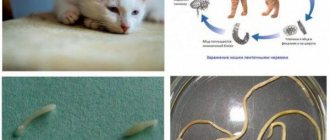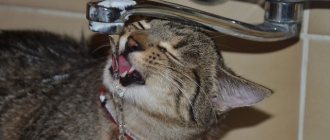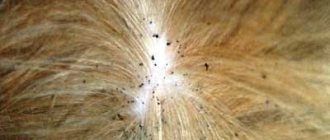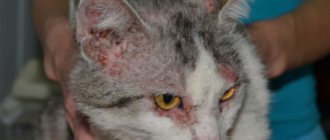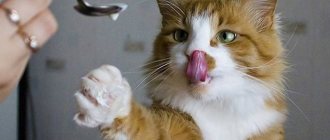Very often you can hear complaints from owners of purring pets that the cat is constantly itching and licking and how to treat the animal in this case. It should be understood that itching is just an external sign that may indicate some kind of disease.
If a cat licks itself, combs itself immediately after waking up or after eating, this is quite normal, this is how it takes care of itself, puts its fur in order, wiping its eyes and ears.
However, if a cat itches almost incessantly, worries, and feverishly licks itself, this is a reason to consult a doctor, since active skin itching may indicate a pet illness or the presence of not fleas, but other parasitic microorganisms on the animal’s body.
Itching may be a signal that this is how cat skin diseases manifest themselves.
Main causes of itching
All causes of itching in cats are divided into several groups.
Ectoparasites
This group includes subcutaneous and cutaneous mites, as well as other blood-sucking parasites. When they appear, dandruff and other flaking appear, hair falls out, and the cat itches until it bleeds.
Severe itching is characteristic of the following diseases:
- Otodectosis. The animal often scratches its ears, face, and shakes its head. As a result of the activity of ear mites, black deposits are noticeable in the shells.
- Sarcoptic mange (pruritic scabies). The cat scratches its neck. If left untreated, the itching moves to the back. Associated symptoms are hair loss at the base of the tail and the appearance of crusts over the body.
- Notoedrosis. The muzzle, back of the head, and brow ridges are susceptible to itching. The animal itches until it bleeds. As a result, the skin becomes rough and thick.
- Cheyletiellosis (wandering scabies). The main symptoms are that the cat itches all the time, and “live dandruff” is noticeable in the tail area. A detailed examination will show that it is not dandruff, but gray skin mites.
- Lice, lice, mites and flea dermatitis. In most cases, fleas and the saliva they secrete are to blame. When infected with them, the cat constantly itches and licks itself. Because of this, hair falls out and bald patches appear.
Allergies
With a food allergy, the cat actively scratches its face and ears, licks and bites its paws. This happens when there is a sudden change in food or the introduction of new foods into the diet. Most often, allergies are caused by insect bites: mosquitoes, wasps, bees, ants.
Interesting! Food allergies in cats often occur when there is a sudden change in food.
Some cat breeds are prone to seasonal allergies. Itching is caused by pollen, house dust, and certain plants. Contact with chemicals and household products also leads to itching and irritation.
Important! Atopic dermatitis cannot be cured. The doctor only prescribes maintenance medications. They reduce symptoms and are given to the animal for the rest of its life.
Contact allergies are a rare type. It occurs when an allergen comes into contact with an animal's skin. As a rule, this is the area of the abdomen and chest. If this type of reaction is suspected, allergy tests are performed.
Skin infections
If your cat is itching but there are no fleas, skin infections may be the cause. They most often join the primary problem. As a result of the activity of bacteria, eczema and weeping wounds develop on the pet's skin. The cat licks them, which causes open wounds.
The development of a fungal disease is indicated by bald areas of the body, peeling and changes in pigmentation. Dermatophytosis manifests itself in individual foci or their connection throughout the body.
Dermatophytosis is characterized by inflammation of the skin in places where it is damaged. These can be insect bites, allergic and neurological wounds. There is redness, swelling or swelling of a certain area on the cat's skin. If an animal scratches its skin vigorously, the temperature of that part of the body rises.
Dry skin
Due to a lack of vitamins A and E in the body, as well as when choosing poor-quality hygiene products, the skin dries out. This process is accompanied by severe itching. First, the cat itches on the sides and back. Then dandruff appears, the skin dries out and cracks in places. The coat does not fall out, but noticeably becomes dull and loses its healthy appearance.
Autoimmune pathologies
Autoimmune pathologies are quite difficult to diagnose and treat. They are characterized by a violation of the body's immune system. As a result, protective cells perceive their own cells and tissues as foreign and attack them.
Important! Discoid lupus erythematosus occurs most often in dogs and is extremely rare in cats.
Such pathological processes are characteristic of diseases:
- Discoid lupus erythematosus. It is characterized by the sudden appearance of wounds and other injuries on the body. In this case, antimicrobial drugs do not give results. Immunosuppressants and glucocorticoids are effective in suppressing this process.
- Jacobs ulcer. This is truly a cat disease. It is characterized by the appearance of a sore on the upper lip of the animal. At first it is a small bubble. Then it turns into an ulcer. If left untreated, teeth and gums become exposed. Antibiotics and wound-healing drugs do not give results.
- Pemphigus foliaceus. The cat itches to the point of sores in the face area. Infections and bacteria often penetrate into scratching areas. This leads to tissue inflammation and the appearance of crusts.
Psychogenic factors
Cats do not tolerate stressful situations well. And at the slightest nervous tension there is a risk of psychogenic itching. The animal begins to chew its tail or itch. In this way the pet calms itself. Soon a dependence on this process arises.
Interesting! Diagnosing psychogenic itch is a complex process. It is determined by excluding other possible causes.
Other reasons
When there are hormonal imbalances, the cat constantly itches and licks. These symptoms are characteristic of the following pathologies.
- Thyroid gland dysfunction. Additionally, hair loss, dullness, dandruff and itching are noted.
- Diabetes. With this disease, cats experience partial hair loss, dullness, dryness, and seborrhea.
- Cushing's syndrome. Improper functioning of the adrenal cortex leads to loss of skin elasticity. Comedones appear on the back and sides.
Cats often itch due to ear infections. Itchy places are the ears, neck and head. With otitis media, discharge containing pus or wax appears from the ears. Marginal seborrhea affects only the tips of the ears. Outwardly, they lose their previous shape, look ugly and unkempt. A bacterial infection is often associated.
Interesting! The most common sign of ear disease is a cat constantly shaking its head.
In the tail area, cats will often wash and lick themselves when the paraanal glands are blocked. The animal can sit and move its butt along the floor. This problem occurs due to poor nutrition. Similar symptoms are characteristic of helminth infection. Determining the exact diagnosis is carried out by exclusion.
Principles of treatment
If your cat licks and scratches his wounds until he bleeds, it is very important to get him medical attention in a timely manner. Typically, treatment includes medication and a special diet. If flea bites are active, your pet will need to be treated with special drops or sprays. If a cat has worms in its body, it is necessary to carry out deworming.
Acaricides will certainly help against ticks. They eliminate parasites and relieve discomfort.
If allergic reactions develop, it is advisable to purchase antihistamines for your cat. If the cat has suffered from an infectious disease, give it antibiotics.
What should the owner do if the cat is itching and licking?
Owners are usually alarmed if a domestic cat frequently licks and scratches itself. And such problems must be resolved immediately. Otherwise, the animal’s behavior will lead to the appearance of deep wounds and scratching. And they are dangerous due to the penetration of pathogenic fungi and bacteria.
There are many reasons for such symptoms. This means that looking for them on your own is pointless and even dangerous. In order not to waste time, the best solution is to contact a veterinarian.
Important! The maximum allowable help from the owners is to treat the pet for worms and fleas. If the animal continues to itch all the time, you need to contact a veterinarian.
Flea dermatitis
One of the common causes of itchy skin in cats is fleas. At the same time, not only bites, but also an allergic reaction to them can cause extremely unpleasant sensations in the animal. Therefore, it is worth carefully examining the cat’s fur, because fleas are quite noticeable insects. They are easiest to notice on the stomach, behind the ears, armpits, on the sacrum and withers. Also, fleas do not like water and shampoo, so they crawl out during bathing.
After consulting with a veterinarian, it is necessary to promptly treat the cat against fleas, for example, using Bars drops, Bars Forte spray, Lugovoy or Bars shampoo. The importance of treatment is not only to rid the pet of the biting parasite, but also to protect it from invasion, for example, cucumber tapeworm, since the flea is a carrier and intermediate host for some parasites. When using the drug, you must correctly follow all instructions from the instructions. It is also very important to treat not only the pet, but also the room to destroy flea eggs and larvae.
Diagnosis of itching in the clinic
There is a certain diagnostic algorithm if a cat’s skin begins to peel, hair falls out, and other dermatological symptoms are observed - it itches, licks:
- Anamnesis collection. The owner provides information about the cat’s breed and age, nutritional habits, and preventive treatments.
- Itching analysis. The doctor determines whether the skin is itchy all over the body or in certain places. Equally important is the frequency and frequency of symptoms.
- Scrapings from places where the kitten itches most often. It is carried out to determine bacterial and fungal infections.
- Analysis for the presence of skin and subcutaneous parasites.
- Examination of the ears for otitis media, ear mites or seborrhea.
- Elimination diet to identify allergens.
- Exclusion of atopic and other types of allergies in cats.
After the diagnosis is made, treatment for the cause itself is prescribed. Elimination of itching is a secondary focus, so the cat may continue to itch during treatment.
Prevention
To prevent your cat from itching, you should regularly treat it with anti-flea medications or wear an anti-parasitic collar. This must be done regardless of whether the animal goes outside or not. Once every six months it is necessary to visit a veterinarian to examine the cat and, if necessary, clean its paraanal glands. Once every 3-6 months, in the absence of contraindications, it is advisable to give the animal a course of vitamins with biotin for healthy skin and coat. If itching occurs, you should seek help from specialists, avoiding self-medication.
Our clinic employs veterinary doctors - dermatologists Ekaterina Sergeevna Novik and Oksana Anatolyevna Maykova. You can find out their work schedule and ask all your questions by calling our phones.
Therapy
You cannot treat a cat that is constantly licking and itching on your own. The diagnostics carried out reveal the true reason for this behavior. And based on it, the veterinarian prescribes a certain set of drugs. Therapy is divided into two groups:
- Etiotropic. The action is aimed at eliminating the cause that causes itching. The most effective option.
- Symptomatic. Treatment is aimed at controlling symptoms, particularly itching. It is temporary. Ineffective.
Important! The owner can help the animal if he follows all the veterinarian’s instructions. Stopping or adding medications on your own can cause serious harm to your cat.
Scabies
The culprits of severe skin itching can be representatives of some types of mites, including ear otodectis, cutaneous cheyletiella and scabies notoedrus.
Notoedrosis
The main symptoms: severe itching, papules that appear on the face, ears and neck. The disease progresses rapidly, the number of papules increases. They also appear on other parts of the body and are located in the form of nests. In addition to them, scabs are visible on the affected areas, the hair may be sticky due to liquid discharge from the papules. To treat the disease, drugs with acaricides are used, for example, Amit Forte solution for external use.
Otodectosis
It manifests itself as frequent scratching due to severe ear itching, the appearance of dark grains in the cavity of the auricle or serous discharge with an unpleasant odor. To treat the disease, the doctor may prescribe ear drops (Bars), drops on the withers (Dironet spot-on). The use of immunomodulators, anti-inflammatory, sometimes anesthetics, and vitamin complexes may also be indicated.
Cheyletiellosis
The main symptom is the onset of severe peeling of the skin (the appearance of dandruff particles). Scaly papules may form. The course of the disease is accompanied by itching. During drug therapy, Dironet spot-on, Amit Forte solution, etc. can be used.
Possible disease
Allergy
This is a common disease, but it is not immediately diagnosed. The main signs include: hair loss, dandruff, otitis media, unpleasant odor from the mouth and hair, scabies, sores, wet armpits. At the same time, the cat chews its paws, rubs its nose, and vigorously licks itself.
Causes of allergies:
- dust, mold, pollen;
- Food;
- flea remedies;
- medical supplies;
- hygiene products;
- infection;
- insect bites;
- reaction after vaccination;
- low-quality material (toys, bedding, drinking bowl);
- breed tendency.
When introducing a new product into the diet or skin and coat care products, it is necessary to monitor the pet's behavior. Food allergies manifest as inflammation around the head, anus, and ears. Vomiting and diarrhea occur.
Experts' opinion
Despite the fact that an animal with its tongue hanging out looks cute and makes you smile, we must not forget about the possible threat to its health
First of all, you need to pay attention to any changes in your pet’s behavior.
First of all, this sign means complete trust and relaxation. If the animal is in a stuffy place and often sticks out its tongue, then it is worth moving it to a cooler room.
Most importantly, any symptoms that occur along with frequent tongue protrusion can signal that the animal is starting to get sick. Some diseases, such as rabies, can cause aggressive behavior in an animal that is dangerous to humans.
Before you start admiring your pet's new ability, you should show it to the veterinarian. There are many dangerous diseases that can be avoided if you just start treatment on time. The examination will not take much time, and you will be sure that the cat’s peculiarity does not cause harm, and you will continue to admire it.
Bacterial infections
The most common causative agent of bacterial skin infections in cats is staphylococcus. As a rule, the impetus for the development of the disease is a violation of the integrity of the skin, a decrease in its protective properties and a general decrease in immunity. The disease is manifested by the formation of pustules or rashes on the skin, discharge, foci of inflammation, hair loss and often itchy skin. To treat the disease, antibacterial drugs are used, including injections, ointments and sprays containing antibiotics. It is also important to identify the root cause and eliminate it.
